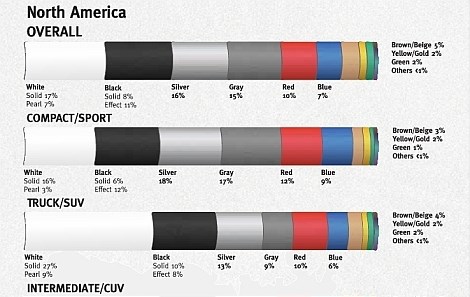White/white pearl dominates the global automotive color popularity ranks for the second consecutive year, according to the 2012 DuPont Automotive Color Popularity Report, released today. Black/black effect moves into second place in the global ranks this year, largely due to the increased popularity in the Asia Pacific market as this color has a worldwide perception of high quality and luxury. Silver fell to third, as its popularity has waned due to its overall gradual decline, especially in the critical large automotive markets of Europe and Asia.
The DuPont report, in its 60th year, is the largest and longest running report of its kind in the automotive industry. It is the only report to include global automotive color popularity rankings and regional trends from 11 leading automotive regions of the world.
White/white pearl moved to top the ranks in Europe in 2012, and was in the leading position as the most popular car color in North America (U.S. and Canada), Japan, South Korea, Russia, South Africa and Mexico. Overall, white/white pearl represents 23 percent of the global market in DuPont’s 2012 report.
Over the past decade, white has held significant rankings in automotive color popularity and is widely seen in other consumer products worldwide. During this timeframe, white’s popularity had been highlighted across all vehicle segments, though historically, it had been most popular among the truck segment. Past advancements in pearlescent whites enabled this color to initially break into the luxury segments.
“Today, white tri-coats are more readily applicable to the global manufacturing base and evoke quality and value among a variety of vehicle segments,” according to Nancy Lockhart, DuPont color marketing manager. “Solid whites have been seen in vanilla shades, stone shades and the current preference of bright whites.”
Black/black effect led among vehicle color popularity in China, but took second place in the global ranks with 21 percent of the world’s share of automotive color. Silver rounded out the top three global color choices, topping the ranks in South America, Brazil and India, but slipped four percentage points to just 18 percent of the overall global automotive market from 22 percent last year.
“Silver peaked during the start of the digital age between 2000 and 2006,” said Lockhart. “We’re seeing more luxury vehicle purchases now that the economy has started to stabilize, and vehicles painted black/black effect are seen as luxury status symbols in several key global markets.”
Red, gray and brown/beige each gained a percentage point since last year’s report, while blue maintained equal share from the 2011 rankings.
The top global vehicle colors in DuPont’s report are as follows:
1. White/White Pearl – 23 percent
2. Black/Black Effect – 21 percent
3. Silver – 18 percent
4. Gray – 14 percent
5. Red – 8 percent
6. Blue – 6 percent
7. Brown/Beige – 6 percent
8. Green – 1 percent
9. Yellow/Gold – 1 percent
10. Others – 2 percent
Related Content
-
This father/son team, inspired by inventor Michael Faraday, focuses on anti-corrosion methods and automated processes to help their Indonesian plating business flourish.
-
From safety critical automotive and aerospace components to lifesaving medical micro-components and implantable devices, Indiana-based Electro-Spec finishes applications that require zero failure rates.
-
Since this new Ohio plater took over the space and assets of a former plating business, it is intentional about setting itself apart from prior ownership.






.jpg;maxWidth=300;quality=90)






